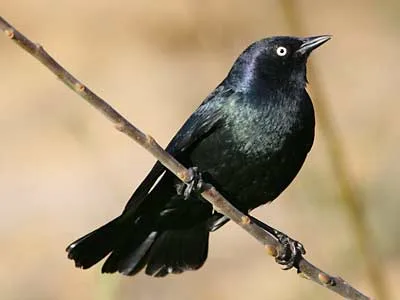
Brewers Blackbird
[order] PASSERIFORMES | [family] Icteridae | [latin] Euphagus cyanocephalus | [UK] Brewers Blackbird | [FR] Quiscale de Brewer | [DE] Purpurstarling | [ES] Tordo de Brewer | [NL] Brewers Troepiaal
Subspecies
| Genus | Species | subspecies | Breeding Range | Breeding Range 2 | Non Breeding Range |
| Quiscalus | cyanocephalus | ||||
| Euphagus | cyanocephalus | NA | w, c | Mexico |
Physical charateristics
A very common and familiar blackbird in the West. Male: All black, with a whitish eye; in good light, purplish reflections may be seen on the head and greenish reflections on the body.
b Female: Brownish gray, with a dark eye.
b Female: Brownish gray, with a dark eye.
Listen to the sound of Brewers Blackbird
[audio:http://www.aviflevoland.nl/sounddb/B/Brewers Blackbird.mp3]
Copyright remark: Most sounds derived from xeno-canto
| wingspan min.: | 36 | cm | wingspan max.: | 38 | cm |
| size min.: | 21 | cm | size max.: | 25 | cm |
| incubation min.: | 11 | days | incubation max.: | 17 | days |
| fledging min.: | 12 | days | fledging max.: | 16 | days |
| broods: | 1 | eggs min.: | 3 | ||
| eggs max.: | 7 |
Range
North America : West, Central
Habitat
Fields, prairies, farms, parks.
Occurs in many kinds of open and semi-open country, including shrubby areas near water, streamside woods, aspen groves in mountain meadows, shores, farmland, irrigated or plowed fields. Often around human habitations, foraging on suburban lawns and in ci
ty parking lots.
Occurs in many kinds of open and semi-open country, including shrubby areas near water, streamside woods, aspen groves in mountain meadows, shores, farmland, irrigated or plowed fields. Often around human habitations, foraging on suburban lawns and in ci
ty parking lots.
Reproduction
Often nests in loose colonies of up to 20-30 pairs. In courtship display (or sometimes in aggressive display), male points bill straight up or forward, fluffs out body feathers, and partly spreads wings and tail.
Nest: Site is quite variable; usually in tree 20-
40′ above ground, but may be on ground among tall grass, in bushes, or in crevice in cliff. Nest (built by female) is a rather bulky open cup made of twigs, grass, weeds, and pine needles, lined with fine grass, rootlets, animal hair. Often has mud or dri
ed manure added to base.
Eggs: 4-6, sometimes 3-7. Pale gray to greenish gray, spotted with brown. Incubation is by female, 12-14 days.
Young: Both parents bring food for nestlings. Young leave the nest about 13-14 days after hatching. 1 brood per year, sometimes 2.
Nest: Site is quite variable; usually in tree 20-
40′ above ground, but may be on ground among tall grass, in bushes, or in crevice in cliff. Nest (built by female) is a rather bulky open cup made of twigs, grass, weeds, and pine needles, lined with fine grass, rootlets, animal hair. Often has mud or dri
ed manure added to base.
Eggs: 4-6, sometimes 3-7. Pale gray to greenish gray, spotted with brown. Incubation is by female, 12-14 days.
Young: Both parents bring food for nestlings. Young leave the nest about 13-14 days after hatching. 1 brood per year, sometimes 2.
Feeding habits
Mostly insects and seeds, some berries. Feeds on a wide variety
of insects, including grasshoppers, crickets, beetles, aphids, caterpillars, termites; also some spiders, snails, tiny crustaceans. Eats many seeds of grasses and weeds, plus much waste grain. Also eats berries, especially in summer.
Behavior:
Walks on the ground as it searches for food. Sometimes wades in very shallow water. Sometimes catches insects in flight. May follow farm machinery in fields to feed on insects turned up by the plow. Except in nesting season, usually forages in flocks.
of insects, including grasshoppers, crickets, beetles, aphids, caterpillars, termites; also some spiders, snails, tiny crustaceans. Eats many seeds of grasses and weeds, plus much waste grain. Also eats berries, especially in summer.
Behavior:
Walks on the ground as it searches for food. Sometimes wades in very shallow water. Sometimes catches insects in flight. May follow farm machinery in fields to feed on insects turned up by the plow. Except in nesting season, usually forages in flocks.
Conservation
This species has an extremely large range, and hence does not approach the thresholds for Vulnerable under the range size criterion (Extent of Occurrence <20,000 km2 combined with a declining or fluctuating range size, habitat extent/quality, or population size and a small number of locations or severe fragmentation). Despite the fact that the population trend appears to be decreasing, the decline is not believed to be sufficiently rapid to approach the thresholds for Vulnerable under the population trend criterion (>30% decline over ten years or three generations). The population size is extremely large, and hence does not approach the thresholds for Vulnerable under the population size criterion (<10,000 mature individuals with a continuing decline estimated to be >10% in ten years or three generations, or with a specified population structure). For these reasons the species is evaluated as Least Concern.

Migration
Southwestern Canada, western and north-central United States. Winters to southern Mexico. Migration:
Present all year in parts of West. Spreads eastward in fall, with winter range including much of Southeast. Migrates north relatively early in spring.
Present all year in parts of West. Spreads eastward in fall, with winter range including much of Southeast. Migrates north relatively early in spring.
Distribution map

